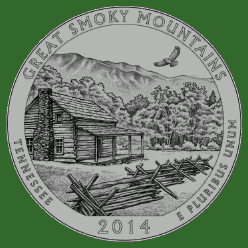Great Smoky Mountains National Park
“It is one of the blessings of wilderness life that it shows us how few things we need in order to be perfectly happy.”
–Horace Kephart, Camping and Woodcraft, 1910
Overview of the Smokies
• Nation’s most visited National Park with more than 14 million visitors in 2021.
• Free admission
• More than 800 square miles in size
• One of the most biologically diverse places on earth, with 6,000 known species of wildflowers, plants and trees, 66 species of mammals including black bears, elk, bobcats and deer, more than 250 varieties of birds, 50 native fish species, more than 80 types of reptiles and amphibians. Eventually, scientists expect to identify 100,000 different species in the park.
• 1,600+ black bears in the park
• Elevation “On Top of Old Smoky” at Clingmans Dome is 6,643 feet
• Excellent hiking on more than 800 miles of trails with 150 different routes
• Camp at 10 developed campgrounds with almost 950 sites, plus hundreds of backcountry camping sites
• Only a single lodge in the park, the hike-in Mt. Le Conte Lodge
• Picnic at 11 developed picnic areas or at any beautiful spot (but protect food from bears)
• Fish 2,100 miles of streams
• More than 380 miles of scenic drives including Newfound Gap Road, Cades Cove Loop and Cataloochee Valley
• 5 historic districts with 100+ preserved buildings
--------------------------------------------------------------------------------
A new Great Smoky Mountains National Park quarter was released by U.S. Mint January 29, 2014, as part of the national park series of coins. Too bad it promotes only Tennessee, even though a majority of the park is in NORTH CAROLINA. Time to move HQ of the Smokies out of Gatlinburg to Asheville, NC.
________________________________________________
Park Headquarters: 107 Park Headquarters Rd., Gatlinburg, TN 37738, visitor information line 865-436-1200; www.nps.gov/grsm; park open 24 hours daily, weather permitting; free.
Directions: From Asheville, take I-40 West to Exit 27 to U.S. Hwy. 74 West towards Waynesville. Turn onto U.S. Hwy. 19 and go through Maggie Valley to Cherokee. Turn onto U.S. Hwy. 441 North at Cherokee and follow the road into the park. Alternatively, enter the Blue Ridge Parkway at any Asheville area entrance point – see below – and follow it south to the parkway terminus at U.S. Hwy. 441 at Cherokee. The parkway route takes about 2 ½ hours, while the I-40/Hwy.19 route takes about an hour, but the parkway route is far more scenic.
The Great Smoky Mountains National Park is America’s most-visited national park, with 14.1 million visitors in 2021, about twice as many visitors as the second most-visited park, the Grand Canyon.
The Great Smokies is one of the largest remaining wild areas of Eastern America, roaming over some 521,000 acres or more than 800 square miles in Western North Carolina and East Tennessee. Slightly more of the park is on the North Carolina side than on the Tennessee side.
Some of the tallest mountains in the East are here, including 16 peaks over 6,000 feet. Clingmans Dome, the highest peak in the park, soars 6,643 feet above sea level and 4,503 feet above the valley floor.
Although many visitors just zip through the park on the main east-west road, U.S. Highway 441, also known as Newfound Gap Road, the park has enough to keep you busy for a week or longer. The Great Smoky Mountains National Park offers extraordinary opportunities for outdoor activities. It has world-class hiking on more than 800 miles of trails, from easy nature walks to multi-day backpacking treks. The Appalachian Trail goes through the park, and North Carolina’s 1,000-mile Mountains-to-Sea Trail (only about one-half finished) begins here. However, some of the most interesting sights in the park are viewable from the comfort of your vehicle. The park has more than 380 miles of roads, paved and unpaved.
Also in the park are the fascinating remains of several communities including Cataloochee, Cades Cove, Roaring Fork and Elkmont. Altogether there are some 100 restored historical buildings in the park, including the best collection of old log cabins in the East.
You can camp at 10 developed front country campgrounds in the park with a total of 939 tent and RV sites, or hike in and camp at around 100 backcountry campsites, each with a capacity of 4 to 20 campers, plus 15 backcountry shelters with a total capacity of near 200. There are no cabins for rent in the park, but many privately operated ones are available on both the North Carolina and Tennessee sides. You also can hike in and stay at rustic Le Conte Lodge, the highest-elevation mountain lodge east of the Rockies. Fish hundreds of miles of trout streams in the park, go tubing in cold mountain streams, explore some of the 40 waterfalls in the park, picnic at any of 11 developed picnic areas or anywhere you find a pleasant spot, or go bicycling or mountain biking. Hire a horse and ride some of the 550 miles of trails open to horses, and if you have your own animal there are five horse camps.
Where there are modest fees for camping ($17.50-$27 a night for developed frontcountry campsites, $4 for backcountry sites) and a few other activities in the park, such as hayrides, overall the Great Smoky Mountains National Park is a great bargain, because access to the park and most of its facilities is always free. This is one of the few major national parks in the country that doesn’t charge admission.
The Great Smoky Mountains National Park has one of the richest and most diverse collections of flora and fauna in the world. It is home to 6,000 known species of wildflowers, plants and trees. About 95% of the park is forested. The Smokies sometimes is called the "wildflower national park," as it has more flowering plants than any other U.S. national park. You can see wildflowers in bloom virtually year-round, although spring and summer are the best times.
Living in Great Smoky Mountains National Park are 66 species of mammals, more than 250 varieties of birds, 50 native fish species and more than 80 types of reptiles and amphibians.
The American black bear is the symbol of the Smokies. At least 1,600 bears are in the park (some estimates are as high as 2,000), a density of about two per square mile. There are more than 6,000 white-tailed deer in the park. The Park Service also has helped reintroduce elk, river otters and peregrine falcons to the Smokies.
For a few short weeks, usually from late May to mid-June, synchronous fireflies put on a light show. In this illuminated mating dance, the male Photinus fireflies blink 4 to 8 times in the air, then wait about 6 seconds for the females on the ground to return a double-blink response.
Probably 100,000 different types of organisms exist in the park, although so far only about 17,000 have been identified and named.
3 - 3



Images of the Great Smokies
Images of the Great Smokies2
Images of the Great Smokies
<
>

All content copyright © Lan Sluder except selected photographs used by permission and brief quotations or other fair use text, which are owned by the copyright holder.
We have made every effort to confirm the accuracy of information on this website, and in the Amazing Asheville book and ebooks, but travel information is subject to frequent change, and no warranty is made, express or implied. Please notify us of any errors or omissions, and we will attempt to correct them as soon as possible. All opinions expressed are those of the author, Lan Sluder, unless otherwise noted.

